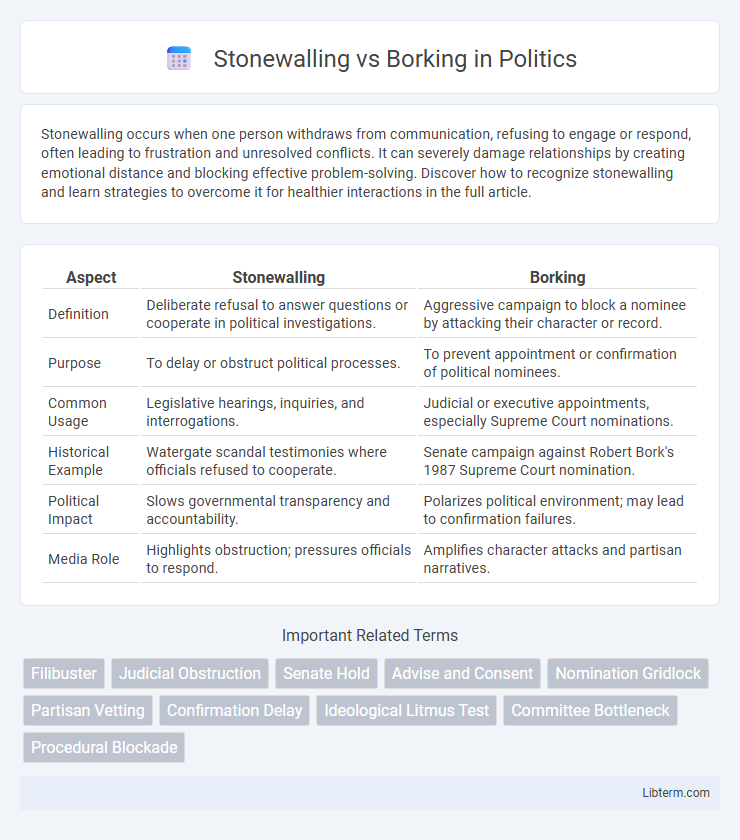Stonewalling occurs when one person withdraws from communication, refusing to engage or respond, often leading to frustration and unresolved conflicts. It can severely damage relationships by creating emotional distance and blocking effective problem-solving. Discover how to recognize stonewalling and learn strategies to overcome it for healthier interactions in the full article.
Table of Comparison
| Aspect | Stonewalling | Borking |
|---|---|---|
| Definition | Deliberate refusal to answer questions or cooperate in political investigations. | Aggressive campaign to block a nominee by attacking their character or record. |
| Purpose | To delay or obstruct political processes. | To prevent appointment or confirmation of political nominees. |
| Common Usage | Legislative hearings, inquiries, and interrogations. | Judicial or executive appointments, especially Supreme Court nominations. |
| Historical Example | Watergate scandal testimonies where officials refused to cooperate. | Senate campaign against Robert Bork's 1987 Supreme Court nomination. |
| Political Impact | Slows governmental transparency and accountability. | Polarizes political environment; may lead to confirmation failures. |
| Media Role | Highlights obstruction; pressures officials to respond. | Amplifies character attacks and partisan narratives. |
Understanding Stonewalling: Definition and Origins
Stonewalling refers to the deliberate refusal to communicate or cooperate, often used as a tactic to delay or obstruct progress in legal or political contexts. The term originates from the physical act of building a stone wall to create a barrier, symbolizing resistance or obstruction. Understanding stonewalling involves recognizing its strategic use to evade accountability or stall decision-making processes.
What is Borking? Historical Context and Meaning
Borking refers to the intense political tactic of obstructing a nominee's confirmation by launching a systematic campaign to discredit or vilify the individual, named after the 1987 Supreme Court nomination battle over Robert Bork. This strategy involves mobilizing media, public opinion, and senators to block the appointment, often by highlighting controversial past views or actions. Borking's historical context underscores its evolution as a powerful tool in partisan judicial and political battles, fundamentally reshaping confirmation processes in the United States.
Key Differences Between Stonewalling and Borking
Stonewalling involves refusing to communicate or cooperate, often to delay or avoid answering questions, while borking refers to systematically attacking or obstructing a person's reputation or nomination, particularly in political or judicial contexts. Stonewalling is characterized by silence and evasion, whereas borking employs aggressive criticism and public campaigns to undermine credibility. These tactics differ in intent: stonewalling aims to stall proceedings, and borking seeks to defeat confirmation or approval through character assassination.
Psychological Impact of Stonewalling and Borking
Stonewalling induces significant psychological distress by creating feelings of isolation, frustration, and helplessness due to emotional withdrawal or refusal to communicate in conflicts. Borking, characterized by a targeted campaign to discredit and undermine an individual's reputation, can result in severe anxiety, social alienation, and long-term emotional trauma. Both tactics erode trust and psychological well-being, with stonewalling impacting interpersonal relationships internally, while borking damages social identity and public perception externally.
Communication Breakdown: How Stonewalling Manifests
Stonewalling manifests as a deliberate refusal to engage in communication, creating a significant communication breakdown by silently withdrawing or giving the silent treatment. This behavior blocks resolution and escalates conflict, often leaving the other party feeling ignored and frustrated. In contrast to Borking, which involves aggressive public character attacks, stonewalling centers on passive non-responsiveness that halts productive dialogue.
Borking in Politics and Public Discourse
Borking in politics refers to the strategic vilification of a public figure, often a judicial nominee, to prevent their confirmation or undermine their credibility. This tactic involves intense media campaigns, personal attacks, and framing opponents as extreme or unqualified, deeply influencing public discourse by polarizing opinions and stalling political processes. The term originates from the 1987 Supreme Court nomination battle against Robert Bork, highlighting the lasting impact of such political maneuvers on nomination procedures.
Motivations Behind Stonewalling and Borking Tactics
Stonewalling involves deliberate obstruction through silence or refusal to engage, often motivated by a desire to control information flow and avoid accountability. Borking is a targeted campaign to discredit or sabotage an individual, driven by political or ideological motives aiming to block appointments or undermine reputation. Both tactics exploit public perception but differ in method and intent, with stonewalling emphasizing evasion and borking focusing on aggressive character attacks.
Recognizing the Signs: Stonewalling vs Borking
Stonewalling manifests as persistent silence or refusal to engage in communication, often accompanied by defensive body language such as crossed arms or avoiding eye contact. Borking involves aggressive public character assassination aimed at discrediting an individual, frequently through media campaigns or social media attacks. Recognizing stonewalling requires noting withdrawal and emotional unavailability, while borking is identified by hostile, targeted efforts to undermine reputation and credibility.
Strategies to Overcome Stonewalling and Borking
Effective strategies to overcome stonewalling include setting clear communication boundaries, encouraging active listening, and implementing time-outs to diffuse tension during conflicts. To counter borking, promote transparency in information sharing, foster bipartisan dialogue, and utilize fact-checking mechanisms to prevent misinformation from derailing discourse. Prioritizing empathy and structured negotiation frameworks enhances resolution efforts in both stonewalling and borking scenarios.
Building Healthy Dialogue: Alternatives to Stonewalling and Borking
Building healthy dialogue requires recognizing and replacing stonewalling, where one partner shuts down communication, and borking, which involves aggressive verbal attacks designed to dominate the conversation. Techniques such as active listening, expressing emotions using "I" statements, and seeking mutual understanding foster empathy and reduce conflict escalation. Encouraging open, respectful dialogue creates an environment conducive to resolution and strengthens relational trust.
Stonewalling Infographic

 libterm.com
libterm.com